It’s been almost a month since our last major post on the excavations at Amphipolis (Amphipolis Tomb Possibly Looted in Antiquity? I am Officially Confused!) and nearly as long since we speculated on who (if anyone) might be eventually found in the tomb (Thinking Out Loud About the Amphipolis Tomb ~ The Rogueclassicist Speculates). School has finally settled down a bit (although the internet has been out for the past few days, or this might have come out earlier), so we finally get a chance to check on the progress of the dig (plenty!) and consider how our working hypothesis about the possible occupant of the tomb is working out. This post will be long and photo-heavy, so give it time to load!
We’ll begin with some photos from August 26, which show something I had long wondered about … the mosaic floors (photos via the Ministry of Culture):
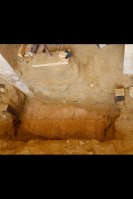
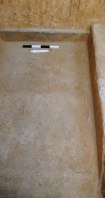
For an awkwardly-worded English report on same: Amphipolis: Pebbled floor came to light (Protothema … tip o’ the pileus to ‘J’ for sending that) along.
Although they need a bit of cleaning, obviously, it is interesting that the second one appears to be in the same sort of style (although on a smaller scale?) as the House of Dionysus at Pella, which dates to the last quarter of the fourth century (via Wikipedia):
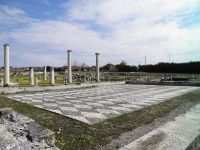
About the same time, we began getting our first speculations in English of people other than Alexander who might be in the tomb. From LiveScience, e.g.:
Michalis Tiverios, an archaeology professor at the Aristotle University of Thessaloniki, told AFP a more likely candidate could be Nearchus, one of Alexander’s admirals, who lived in Amphipolis.
At the end of August, archaeologists had cleared the first chamber behind the ‘sphinxes’ and were assessing construction techniques and what needed to be done. (Ministry of Culture Press Release). They had also found yet another style of mosaic floor (white stones set in a red matrix … source):

Meanwhile, the Greek Television Station ENA flew a helicopter over the site which nicely demostrates how HUGE this thing actually is:
We also began to hear about the ‘circus-like’ atmosphere the archaeologists had to contend with by this point … from Greek Reporter comes an excerpt:
An official source, who has knowledge of the tomb’s excavation progress, claims that the archaeologists and crew cannot do their job as their mobile phones keep ringing and they have to fend off TV cameras and microphones shoved in their faces every day. They receive calls from politicians and journalists who are eager to know when they will go inside the tomb and what they expect to find there. Also, they have to answer speculations, wishes, and wild conspiracy theories. They even have to answer to technical details such as what kind of cameras they use to look inside the tomb without demolishing the protective wall. And all this while the initial excavation is still in progress!
At the same time, crowds of people gather all day long around the site that looks more and more like a community fair. Eager tourists and locals rush to see the media’s new archaeological Disneyland first, while the smoke from the souvlaki and hot dogs grills fills the air. Under the five-meter lion’s imposing gaze, a vendor from nearby village Strymoniko is selling peanuts, a way to survive in crisis-hit Greece.
- via: Amphipolis Tomb: All Circus, No Bread at Greece’s Newly Found “Archaeological Disneyland” (Greek Reporter)
We also had our first (in English) OpEd piece on how politicized the discovery was becoming … an excerpt from Kathimerini:
[…] It is not hard to imagine the impact of such a discovery if we take a look at the existing evidence. It is a known fact that Greece has long been at odds with Israel over who can claim the lead in nationalized and politicized archaeology, often in a way that is an affront to the scientific community. Let us take the findings of excavations in northern Greece, for example, constantly cited to suit political circumstances and often acting as ambassadors of national policy: The findings and their interpretation are used to prove the primal Greekness of the Macedonians and once and for all silence our unmentionable neighbors to the north who, surrendered to their own obsessive national policy, are seeking control over parts if not all of our Macedonian heritage.
Now, the ancient relics of Amphipolis are once more being linked to the name dispute and being used for petty political interests. They are being presented by the state and by many representatives of the media as the final confirmation of Macedonia’s Greekness, even though as a country we have staunchly supported this fact for the past 20 years. We have also heard it said that the findings at the tomb have steeled the morale of disheartened Greeks. First of all, with so many surpluses about, surely the Greeks are no longer disheartened. And second, if our morale has sunk to such a low (despite the Parthenon, Olympia, Delphi, Knossos and Vergina) that it needs a tomb to be revived, then there is much more we need to be worried about.
We have also heard that the discoveries at Amphipolis are contributing to the improvement of Greece’s international image – ergo, they may boost tourism. If the government really had such a high regard of archaeology, then why is it cutting back funding to the extent of causing major operational problems at excavations, sites and museums?
- via: Politicized archaeology (Kathimerini)
After much shoring up/stability work, on September 7 we got our first set of photos showing the Karyatids which ‘womanned’ the entrance to the next chamber (source):
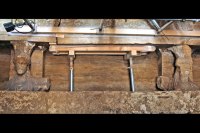


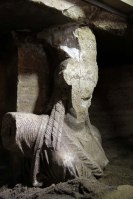

Incredibly nice pieces and enough to spark a major interest (finally) on the part of the English world press. What I found particularly interesting was that the Karyatids were missing their arms (I’ll be returning to that below, although see Dorothy King’s post on the Karyatids). According to the Telegraph’s brief coverage:
[…] “The structure of the second entrance with the Caryatids is an important finding, which supports the view that it is a prominent monument of great importance,” the ministry said.
The face of one of the Caryatids is missing, while both figures have one hand outstretched in a symbolic move to push away anyone who would try to violate the tomb. […]
A better bit of coverage came from Dorothy King, whose post puts the Karyatids in context very nicely: The Amphipolis Caryatids
Edith Hall has also provided some useful background to Karyatids: CARYATIDS IN A (WAL)NUT SHELL
A couple days later, the Ministry release a really nice little reconstruction sort of thing showing where the finds to this point came from:
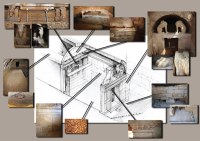
Then, on September 11, we were given the ‘full reveal’ of the Karyatids (source):



The wall behind the Karyatids revealed a very nice (it seems) Ionic doorway:
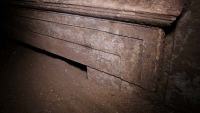
I’ve never seen three ‘nested’ blocks before, but I’m sure it’s not uncommon. In any event, after that came another domed chamber, which wasn’t filled with as much sandy soil as the previous two; the photos aren’t overly exciting, but can be viewed here. More shoring up was in order. Today’s press release added more details on work to be done, but also included some more photos of the Karyatids, which stand 2.27 m. tall and still bear traces of paint (source).




We should note that Dr Olga Palagia has been long suggesting that the tomb actually dates to Roman times and contains the bodies of those who fell at the battle of Phillipi, a few centuries later than the current date. Her views haven’t been much presented in the English press, but she did give a full interview to a Greek newspaper: Όλγα Παλαγγιά: Το μνημείο της Αμφίπολης χρονολογείται στη Ρωμαϊκή εποχή (September 16). For what it’s worth, the English media seem to be unwilling to name Dr Palagia, e.g., from Kathimerini:
The archaeologist leading the dig at Ancient Amphipolis insists that the tomb at Kasta Hill she and her colleagues are searching was built in the late 4th century BC.
“I firmly believe that this monument is from the last quarter of the 4th century BC and we have all the proof for this,” said Katerina Peristeri on Thursday.
“It is futile for other archaeologists to come out and talk about it being from the Roman era or anything else.”
Archaeologists entered the third chamber of the tomb, which has been linked to Alexander the Great, last Friday.
- via: Leader of Amphipolis dig insists on tomb date (Kathimerini)
I’m sure we’ll be getting some major news next week. Until then, you can peruse a piece from Greek Reporter which nicely sums up all the speculation about who might be in the tomb:
While evidence shows that archaeologists are one step away from uncovering the “big secret” of Amphipolis, Greece, people are speculating on who is buried under Casta hill. Archaeologists and other world experts have supported different theories on who is the important ‘tenant’ of the Casta Hill. See the most popular ones below:
Olympias
Mother of Alexander the Great, wife of Philip II, king of Macedon, and daughter of King Neoptolemus of Epirus. Cassander had her murdered by stoning in 316 BC. (Read full story)
Androsthenes, Laomedon and Nearchus
Alexander the Great’s three admirals are closely connected to Amphipolis. Androsthenes and Laomedon were born there while Nearchus was either born or exiled in Amphipolis.
Cassander
Son of Antipater, did not follow Alexander’s army in Asia. He stayed with his father in Macedonia and used to fight with Polyperchon but eventually allied with him, when he killed Alexander’s son, Heracles. In 311 BC, he killed Alexander’s second son and successor, Alexander IV, along with his mother Roxana. He died of edema in 279 BC.
Polyperchon
He served under Philip and Alexander. He returned to Greece from Asia in 324 BC -after the death of Alexander- and was appointed regent of Macedon by Antipater in place of the latter’s son, Cassander.
Philip II of Macedon
Some do not believe that the tomb of king Philip was located in Vergina. Meanwhile, others claim that ancient Greeks might have built a second monument in Amphipolis to commemorate the king.
Heracles
Son of Alexander who was murdered with his mother, Barsine.
Alexander IV
The twelve-year-old son of Alexander and Roxana who was murdered along with his mother by Cassander. If his grave is located in Vergina, then it is possible that someone buried him and disposed of his mother’s corpse.
Alexander the Great
Alexander sailed from Amphipolis to Asia. However, it is almost certain that his tomb is located in Alexandria, since people such as Julius Caesar have visited his burial site. Some, however, insist that his bones were moved to Amphipolis by Olympias, while others argue that it is a cenotaph “waiting” to receive him, or a second monument in his honor.
Cenotaph or Memorial
This view is supported by the various influences on the monument’s construction as well as its size.
Hephaestion
General of Alexander’s army. Professor Theodoros Mavrogiannis believes that the Casta hill tomb belongs to Hephaestion and claims that the tomb was built in 325 BC by order of Alexander himself.
Roxana
The wife of Alexander became the mother of his son in 323 BC after Alexander had died. Roxana fled to Epirus in order to be saved by his descendants, and later went to Amphipolis, where she was murdered by Cassander in 310 BC.
Antigonus Monophthalmus
General of Alexander’s army, was proclaimed king in 306 BC and demanded that Cassander gives him Macedon. He died eighty-one years old and was buried with royal honors.
Philip Arrhidaeus
Son of king Philip. After Alexander’s death, he was proclaimed king by the Macedonian army as Philip III of Macedon. He was killed by soldiers who defected against Olympias. His bones were transported by Cassander to Aegae.
- via: 13 Alexander-Era Figures Who May Be Buried in the Amphipolis Tomb (Greek Reporter)
For my part, I continue to cling to my hypothesis that the tomb was intended for Alexander, but when his body was hijacked and sent to Alexandria by Ptolemy, the tomb itself was sealed up within a few years as it really could not have been used by someone else without political implications. The more I see missing parts of sculpture, e.g., heads of ‘sphinxes’, arms of Karyatids, that don’t seem to be broken off (the arms of the Karyatids don’t look like they were actually attached) — with the caveat that their existence/finding may not be reported in the press — the more I think this tomb was unfinished. Perhaps as well, parts were removed to ensure that it was considered unfinished and, therefore, empty.
That said, I find Olga Palagia’s theory interesting, but would really like to hear more details from both sides on what is being used to establish the date of the tomb. That the mosaic floor in one part of the tomb stylistically matches something from Pella is probably important in this regard. There must also be ceramics in the soil being removed; there might also possibly be organic matter which can be given the C14 treatment.
Finally, by way of ‘conclusion’ we should also note that Dorothy King has penned a number of blogposts answering ongoing questions about the tomb along the way:
- Quick Answers About Amphipolis (Updated) (September 8)
- Amphipolis: Walling Up … (September 9)
- Sphinxes: not just at Amphipolis! (September 10)
- Quick Answers About Amphipolis … (September 20)
- Amphipolis: Your Questions, My Answers … Part Deux (September 20)
- Amphipolis: More Questions, More Answers … (September 21)
